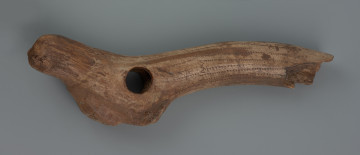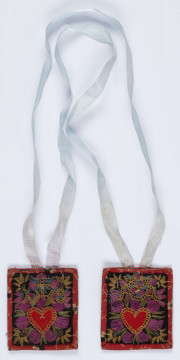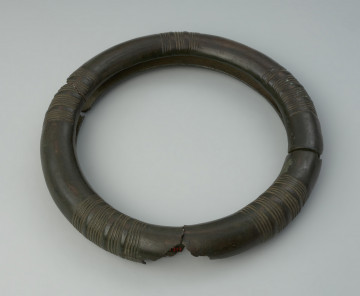
Shaman staff from Szczecin-Podjuchy
9600 p.n.e. — 4100 p.n.e.
National Museum in Szczecin
Part of the collection: Stone Age
The insignia (chief's?) from Rusinowo made of moose antlers were found in 2003 by one of the inhabitants of Powalice, the Świdwin Poviat, in his field, on a pile of chalk used for soil fertilisation. In 2004, the relic was handed over to the staff of the Archaeology Department (Dział Archeologii ) of the National Museum (Muzeum Narodowe) in Warsaw. Thanks to the cooperation with the finder, it was possible to establish that the chalk in which the object was deposited came from the Rusinowo excavation site located a few kilometres from Powalice. The object is richly ornamented with a series of zigzag patterns. The attention is also drawn by a schematic representation of a human figure. Depending on the object's orientation, the ornamentation can be interpreted as a standing male figure with arms outstretched or a sitting female figure with legs outstretched (a woman giving birth in a squatting position). The image of a human figure makes this find unique as it is the oldest known representation of a human being in Pomerania (at the same time, one of the two connected with the spiritual culture of hunter-gatherers in this area) and one of the oldest from the Baltic areas. The insignia was made with flint tools from the antlers of an elk antler of a male, aged about 10-15 years, of medium build. There are no traces of use on it, which suggests that it had a symbolic meaning from the very beginning, but the damage is visible, suggesting that it must have functioned for a very long time. Perhaps it is a type of symbol passed down from generation to generation within a single tribe. Thanks to examining plant pollen from the sediments in which the insignia rested, it was possible to establish that at its deposition in the water reservoir, the dominant environment type was pine and birch forest with juniper thickets. Radiocarbon methods date the insignia between 10776 and 10641 cal BC from the Allerød and early Dryas and associate it with one of the archaeological cultures of that period: Federmesser, Bromme or Ahrensburg.
Michał Adamczyk
Other names
magic stick from Rusinowo
Author / creator
Dimensions
cały obiekt: height: 41 cm, width: 7.3 cm
Object type
mobiliary art, insignia
Technique
printing, breaking, setting, cutting, chopping, softening
Material
moose antlers
Origin / acquisition method
donation
Creation time / dating
Creation / finding place
Owner
National Museum in Szczecin
Identification number
Location / status

9600 p.n.e. — 4100 p.n.e.
National Museum in Szczecin

1801 — 1900
National Museum in Lublin

around 600 p.n.e. — 400 p.n.e.
National Museum in Szczecin
DISCOVER this TOPIC
Museum of King Jan III's Palace at Wilanów
DISCOVER this PATH
Educational path